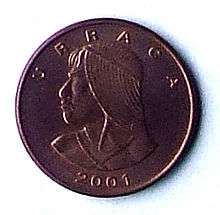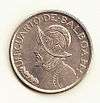Panamanian balboa
The balboa (sign: B/.; ISO 4217: PAB) is, along with the United States dollar, one of the official currencies of Panama. It is named in honor of the Spanish explorer/conquistador Vasco Núñez de Balboa. The balboa is subdivided into 100 centésimos.
| Panamanian balboa | |||||
|---|---|---|---|---|---|
| Balboa panameño (Spanish) | |||||
| |||||
| ISO 4217 | |||||
| Code | PAB | ||||
| Number | 590 | ||||
| Denominations | |||||
| Subunit | |||||
| 1⁄100 |  Centésimo | ||||
| Symbol | B/. | ||||
| Banknotes | None (U.S. banknotes are employed instead, although denominated in balboas) | ||||
| Coins | 1 and 5 centésimos, 1⁄10, 1⁄4, 1⁄2, and 1 balboas | ||||
| Demographics | |||||
| User(s) | |||||
| Valuation | |||||
| Pegged with | U.S. dollar at par | ||||
1 Panama now uses U.S. dollar notes. | |||||
History
The balboa replaced the Colombian peso in 1904 following the country's independence. With the exception of a fluctuation in 2016, the balboa has been tied to the United States dollar (which is also legal tender in Panama) at an exchange rate of 1:1 since its introduction and has always circulated alongside dollars.
Panama has never had an official central bank.[1] The National Bank of Panama, one of two government-owned banks, was responsible for nonmonetary aspects of central banking in Panama, assisted by the National Banking Commission (Superintendencia del Mercado de Valores), which was created along with the country's International Financial Center, and was charged with licensing and supervising banks.[2]
Coins
Current
| Denomination | Obverse | Reverse | Diameter | Thickness | Mass | Composition | Edge | Minted | |
|---|---|---|---|---|---|---|---|---|---|
| Un centésimo (B/. 0.01) |  |
Urracá | Denomination | 19.05 mm | 1.55 mm | 3.11 g | Copper 95% Tin/Zinc 5% |
Smooth | 1935–1982 |
| 2.50 g | Copper 2.5% Zinc 97.5% |
1983–Present | |||||||
| Cinco centésimos de balboa (B/. 0.05) |  |
Denomination | Panamanian Coat of Arms | 21.21 mm | 1.95 mm | 5 g | Copper 25% Nickel 75% |
Smooth | 1929–Present |
| Un décimo de balboa (B/. 0.10) |  |
Vasco Núñez de Balboa | 17.91 mm | 1.35 mm | 2.268g | Copper 91.67% Nickel 8.33% |
118 reeds | 1966–Present | |
| Un cuarto de balboa (B/. 0.25) |  |
24.26 mm | 1.75 mm | 5.67g | 119 reeds | ||||
| Medio balboa (B/. 0.50) |  |
30.61 mm | 2.15 mm | 11.34 g | 150 reeds | 1973–Present | |||
| Un balboa (B/. 1) |  |
Liberty with Panamanian Coat of Arms | 38.1 mm | 2.58 mm | 22.68 g | reeded | 1973–2010 | ||
| Panamanian Coat of Arms | 26.5 mm | 2 mm | 7.2 g | Outer ring: Nickel-plated steel Center: Nickel-brass-plated steel |
reeded with inscription | 2011–Present | |||
Obsolete
| Denomination | Obverse | Reverse | Diameter | Thickness | Mass | Composition | Edge | Minted |
|---|---|---|---|---|---|---|---|---|
| Medio Centesimo de Balboa (1⁄2¢) (No longer used since 1940) |
Vasco Núñez de Balboa | Denomination | Copper-nickel | Smooth | 1907–? | |||
| Uno y Cuarto Centesimos (1 1⁄4¢) <all>(No longer used since 1970) |
Vasco Núñez de Balboa | Denomination | Copper 95% Tin/Zinc 5% |
Smooth | 1940 | |||
| Dos y Medio Centesimos de Balboa (2 1⁄2¢) (No longer used since 1976) |
Vasco Núñez de Balboa | Denomination | 18 mm | 3.3 g | Copper-nickel | Smooth | 1907–? | |
| Panamanian Coat of Arms | Various Designs | 10 mm | 1.25 g | Copper-nickel-plated copper | 1973–1976 |
In 1904, silver coins in denominations of 2 1⁄2, 5, 10, 25, and 50 centésimos were introduced. These coins were weight-related to the 25-gram 50 centésimos, making the 2 1⁄2-centésimos coin 1.25 grams. Its small size led to it being known as the "Panama pill" or the "Panama pearl". In 1907, copper-nickel 1⁄2- and 2 1⁄2-centésimo coins were introduced, followed by copper-nickel 5-centésimo coins in 1929. In 1930, coins for 1⁄10, 1⁄4, and 1⁄2 balboa were introduced, followed by 1 balboa in 1931, which were identical in size and composition to the corresponding U.S. coins. In 1935, bronze 1-centésimo coins were introduced, with 1¼-centésimo pieces minted in 1940.
In 1966, Panama followed the U.S. in changing the composition of their silver coins, with copper-nickel-clad 1⁄10 and 1⁄4 balboa, and .400 fineness ½ balboa. One-balboa coins, at .900 fineness silver, were issued that year for the first time since 1947. In 1973, copper-nickel-clad 1⁄2-balboa coins were introduced. 1973 also saw the revival of the 2 1⁄2-centésimos coin, which had a size similar to that of the U.S. half dime, but these were discontinued two years later due to lack of popular demand. In 1983, 1-centésimo coins followed their U.S. counterpart by switching from copper to copper-plated zinc. Further issues of the 1-balboa coins have been made since 1982 in copper-nickel without reducing its size.
Modern 1-, 5-centésimo, 1⁄10-, 1⁄4-, and 1⁄2-balboa coins are the same weight, dimensions, and composition as the U.S. cent, nickel, dime, quarter, and half dollar, respectively. In 2011, new 1-balboa bimetallic coins were issued[3] that are the same dimensions as the U.S. dollar coin.
In addition to circulating issues, commemorative coins in denominations of 5, 10, 20, 50, 75, 100, 150, 200, and 500 balboas have also been issued.
Banknotes
In 1941, President Arnulfo Arias pushed the government to enact Article 156 to the constitution, authorizing official and private banks to issue paper money. As a result, on 30 September 1941, El Banco Central de Emisión de la República de Panamá (Central Bank of Issue of the Republic of Panama) was established.[4]
The bank was authorized to issue up to 6,000,000 balboas' worth of paper notes, but only 2,700,000 balboas were issued on 2 October 1941. A week later, Ricardo Adolfo de la Guardia Arango replaced Arias as president in a coup supported by the United States.[5] The new government immediately closed the bank, withdrew the issued notes, and burned all unissued stocks of same. Very few of these so-called "Arias Seven-Day" notes escaped incineration.
Exchange rate
| Current PAB exchange rates | |
|---|---|
| From Google Finance: | AUD CAD CHF EUR GBP HKD JPY USD |
| From Yahoo! Finance: | AUD CAD CHF EUR GBP HKD JPY USD |
| From XE.com: | AUD CAD CHF EUR GBP HKD JPY USD |
| From OANDA: | AUD CAD CHF EUR GBP HKD JPY USD |
| From fxtop.com: | AUD CAD CHF EUR GBP HKD JPY USD |
See also
References
Citations
- https://mises.org/library/panama-has-no-central-bank
- http://www.country-data.com/cgi-bin/query/r-9985.html
- "World Coin News: panama". Worldcoinnews.blogspot.com. Retrieved 2017-04-28.
- Linzmayer, Owen (2012). "Panama". The Banknote Book. San Francisco, CA: www.BanknoteNews.com.
- . AP. 1998-08-11 https://www.washingtonpost.com/archive/local/1988/08/11/oft-deposed-ex-leader-of-panama-dies/98528e7f-98ac-491f-b6ae-3aa3c9a2d839/. Missing or empty
|title=(help)
Sources
- Krause, Chester L.; Clifford Mishler (1991). Standard Catalog of World Coins: 1801–1991 (18th ed.). Krause Publications. ISBN 0873411501.
- Pick, Albert (1994). Standard Catalog of World Paper Money: General Issues. Colin R. Bruce II and Neil Shafer (editors) (7th ed.). Krause Publications. ISBN 0-87341-207-9.
